
The buildings that greet you when you arrive on North Manitou Island are the “village.” For all but a few years, this was the only village on the island, so it needed no other name. The settlement began when Nicholas Pickard moved his cordwood station from the south end of the island to this location in the mid-1850s. Lumbering and fishing dominated the early years but none of the existing buildings are connected with these activities. The surviving buildings are related to three later activities. The U.S. Life-Saving Service Station sits along the beach; Cottage Row sits on the bluff behind the station and the rest of the village buildings are from the Manitou Island Association (MIA) Farm that dominated island agriculture. As you explore the village please respect the privacy of those who live here. U.S. Life-Saving Service ComplexAs you leave the dock, the first house you see on your left is the Hans Halseth house. It is now used as a private residence for NPS staff. The house was built in 1890 near Nicholas Pickard’s dock north of the village. It was relocated here in 1910, and the shed behind it was built at about the same time. This simple 1.5 story wood-frame, side-gabled house was the residence of surfman, Hans Halseth and is a good example of the modest dwellings that USLSS crew members lived in. The 1854 Volunteer Rescue Station is located about 50 feet southeast of the Hans Halseth house. It is the only structure of its kind from the 1854 federal appropriation to place volunteer rescue stations along the Atlantic Seaboard and the Great Lakes. Nicholas Pickard and his lumber crew built this structure from written specifications provided by the Treasury Department upon receipt of a bond for a Francis Metal Surfboat to be delivered to his care and use. The 1.5 story front-gabled building has a heavy timber frame, and walls sheathed with cedar boards. The 1877 U.S. Life Boat Station and Capstan is the next building. Francis Chandler designed the structure as the architect for the Treasury Department. The structure is an open one-story boat house with a clipped gable roof. It was later renovated by the MIA, which removed the boat door and added a new door and new windows. They also removed the lookout tower, which originally had surmounted the roof of the building. The 1887 U.S. Life-Saving Service Dwelling was designed by Albert Bibb as the architect for the Treasury Department. The design is believed to be unique in the nation. The 2-story structure is roughly square with a steep gabled roof and a large central cross gable. The U.S. Coast Guard remodeled the dwelling in 1932, and the MIA further altered the building during the 1940s and 1950s to serve as quarters for its employees and a lodge for guests. Located a few feet southeast of the USLSS Dwelling is the Crew Ready Room, which was built in 1895 as a supply building. The small hip-roofed structure was later adapted for use as a place where on-duty crew members could wait until called into action for a drill or emergency. In the 1940s, the MIA renovated the interior for use as living quarters, and the NPS now uses the building for staff housing. The Root Cellar was constructed in 1899 by the Life-Saving Station crew using fieldstone and mortar for the walls and a gable roof clad with wood shingles. It was used to store carrots, onions, cabbage, and other food purchased from island farmers. 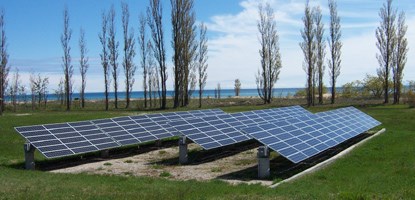
Kerry Kelly 2005 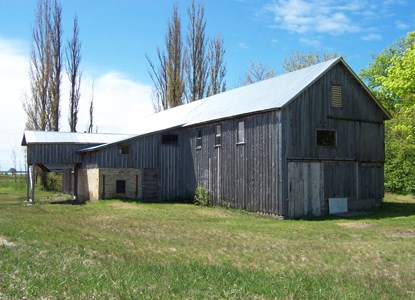
Kerry Kelly 2005 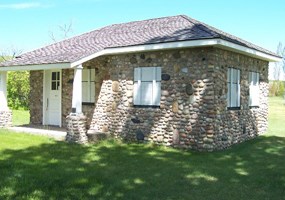
Kerry Kelly 2006 Cottage RowNow let’s head back toward the dock. As you approach the generator building, turn right (away from the dock), and you will see the Manitou Island Association (MIA) office. It is a simple rectangular building with fieldstone walls. It reflects MIA’s concept of the farm as a business and the association’s hierarchical managerial structure. 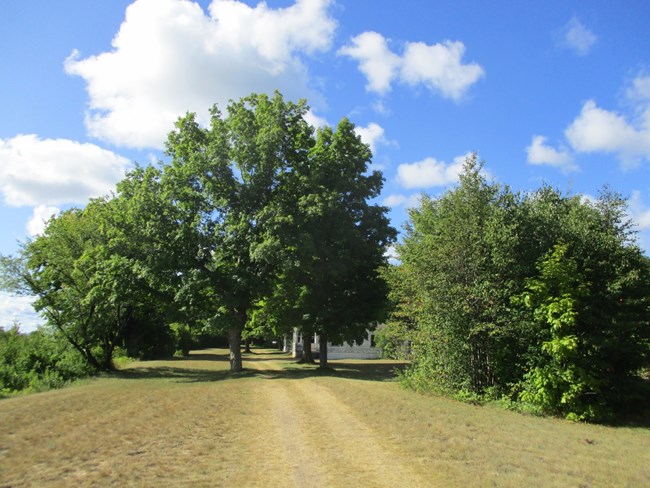
Susan Pocklington, Preserve Historic Sleeping Bear Cottage Row is a series of cottages that were built between 1893 and 1924 on the bluff overlooking the Life-Saving Station. Ten neighboring lots were divided and included a park, where each had 1/10th ownership with the understanding that no construction other than boathouses and ancillary structures could be built. The land was owned by Silas Boardman, a Chicago business man, who had come to NorthManitouIsland in the 1880s for his health. He had begun an orchard business with Fredric Beuham on the island and was visited by his daughter Carrie and her husband George Blossom. The Blossoms and their friends Fredrick and Mary Trude purchased the land to sell to their friends who to build cottages where they could vacation together just a one-day boat ride from Chicago. 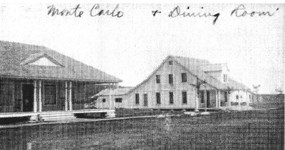
NPS Files Walking down the site of the old board walk on Cottage Row, the first building you come to is the Blossom cottage also known as (Monte Carlo). Constructed in 1893 by George and Carrie Blossom, it is situated directly north of Cottage Row. The cottage shared this plot with the former home of the U.S. Lifesaving Service keeper Daniel Buss, which was moved from its original location near the Lifesaving Station. The house was remodeled to serve as a communal dining facility for Cottage Row property owners. The original cottages on Cottage Row did not have kitchens or dining rooms since they would eat at the dining hall. The dining hall was eventually converted into a lodge for guests of the MIA, but it was destroyed by fire in 1953. It is believed that George and Carrie Blossom commissioned a young, unknown 26 year old Frank Lloyd Wright to design and build them a cottage. Wright had designed their home in Oak Park, IL which was built in 1892. The structure is known as a “dog-trot” style house, based on buildings that Wright worked on while at Louis Sullivan’s office in Chicago. 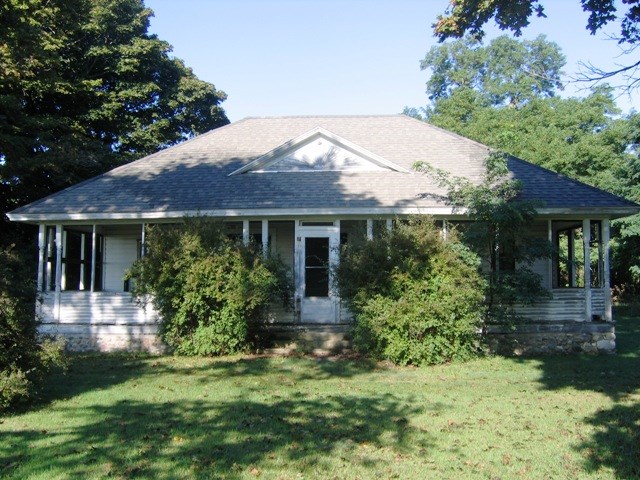
Susan Pocklington, Preserve Historic Sleeping Bear The "dog-trot" design had room arranged along each side of a covered breezeway with doors opening into the central passage. The origins of this design are traced to the gulf coast area of Mississippi, where it later evolved into a bungalow house type with a breezeway that was enclosed to form a central room with a verandah that extended across the front of the house to catch the on-shore breezes to cool the house naturally. 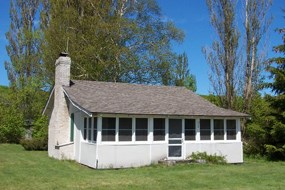
Kerry Kelly As you walk south along the path away from the Monte Carlo Cottage, you will the Life-Saving Station across the lawn on your left and a series of cottages and houses on your right. This row of lots was called Cottage Row. There were 10 lots numbered from the south to the north, so the first lot you come to is Lot 10. Cottage Row Lot 10 – This lot was never built on. During the 1930s and 1940s the lot was used as a small alfalfa field intended to entice deer to the area. Cottage Row Lot 9 – Howard Foote built his second cottage here in 1901. The house was destroyed by fire in 1935 and in its place, Foote’s daughter, Shirley Foote Alford erected a small house purchased as a kit from Sears & Roebuck. A cabin built by the MIA during the 1930s to house migrant orchard workers is behind the cottage. 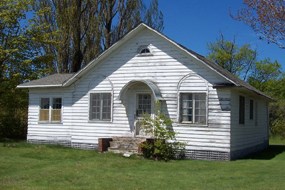
Kerry Kelly Cottage Row Lot 8 – The Margaret Riggs Cottage was built in 1924 by Nicholas Feilen, who had built several of the other cottages on the island. While there is no front verandah, the floor plan is similar to the Monte Carlo cottage. Note the arch-roofed hood that projects over the front stoop. Cottage Row Lot 7 – No building was built on Lot 7. 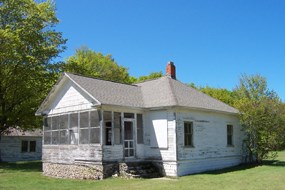
Kerry Kelly Cottage Row Lot 6 – The lot was purchased by John Keating in 1894 and built a cottage the following year. During the early 1940s the Keating cottage was relocated to a site north of the Campbell house. Lacking a stable foundation at the new site, the structure collapsed and has been removed. Cottage Row Lot 5 – Howard Foote owned a music store in Chicago and had a booth at the 1893 Chicago World’s Columbian Exposition. At the close of the Fair in October 1893, he dismantled all of the booths surrounding his and loaded the materials and two carpenter brothers, John and Nicholas Feilen, onto a boat with instructions to begin building cottages on NorthManitouIsland when they arrived. The Feilen’s modified the dog-trot plan for the Blossoms when constructing this cottage. In 1900 Foote sold the cottage to S.W. McMunn, the father of Mary Bournique. 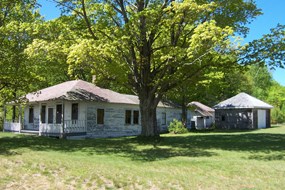
Kerry Kelly Cottage Row Lot 4 – The Frederick and Mary Trude Cottage was also built by John and Nicholas Feilen in 1894. The Trudes were one of the developers of the Cottage Row resort colony, and this cottage is one of the three houses based on the dog-trot architectural plan similar to the Monte Carlo cottage. This cottage and the Foote cottage were constructed of materials reused from dismantled exhibition booths of the Manufacturers’ Building at the 1893 Chicago World’s Columbian Exposition. 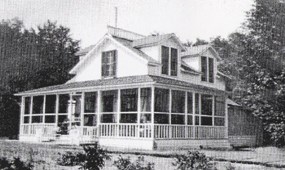
NPS Photo Archive Cottage Row Lot 3 – The George and Carrie Blossom Cottage was originally located in the farmhouse yard of Silas Boardman’s farm near the site of the dining hall. It was moved to the Cottage Row lot in 1894. The 1 ½ story structure had a light wood frame and gabled dormers with a full verandah across the front. The Blossoms later sold the cottage to the Burdick family, who called it Tanglewood.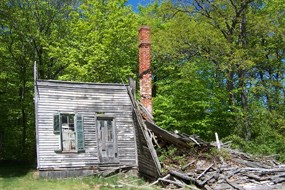
Kerry Kelly 2005 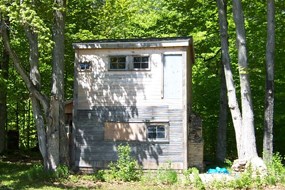
Kerry Kelly Cottage Row Lot 2 – The Hewitt cottage was built in 1895 or 1896. It was a shingle-style cottage furnished in “burlap and calico” and was described as “the prettiest cottage of all.” A few years later the Hewitts sold the cottage to Dr. John Edwin and Louise Rhoades. In a wooded area adjacent to the cottage, the Rhoades’ built a small play house for their daughter, Margaret. Shortly after Margaret married Roderick Peattie, a lower floor was added to the play house, transforming it into a small, two-story, private cottage they called the Treehouse. The cottage eventually fell into disrepair and was removed, but the Treehouse remains. It was restored by the NPS in 2004. 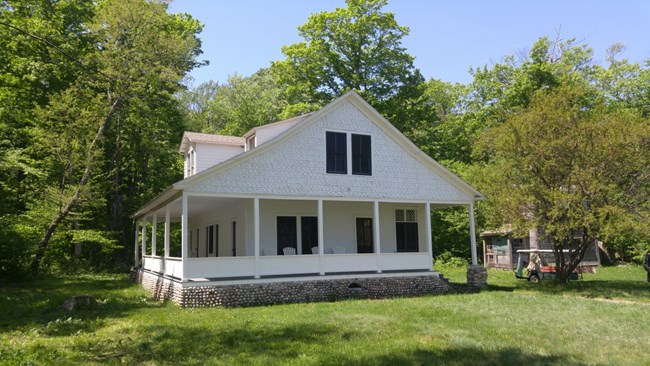
Vince Sadowski Cottage Row Lot 1 – The Katie Shepard Hotel, “The Beeches” was built in 1895 for Mrs. William Shepard for their daughter Katherine, who was popularly known on the island as “Miss Katie.” She opened the house as a hotel known as The Beeches around the time the Newhalls began logging around 1908 when they discontinued meal service at the dining hall at the northern end of Cottage Row. Miss Katie operated the hotel and dining room until poor health forced her to discontinue the business in the early 1930s. 
|
Last updated: October 3, 2024
